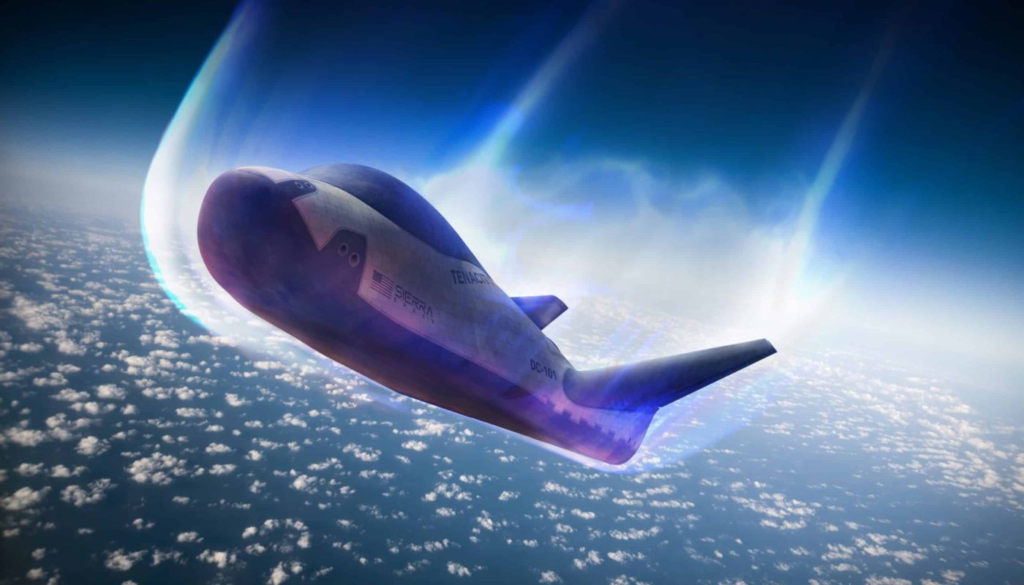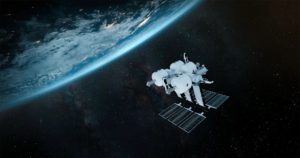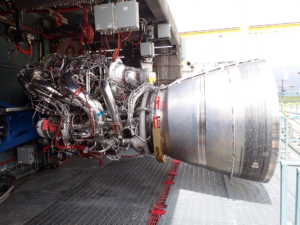
Dream Chaser Tenacity Is Almost Ready To Launch!
After decades of development and testing, Dream Chaser Tenacity, the first test article, is verticle and at NASA’s facility. It’s about to complete vibration testing in conjunction with the Shooting Star module and is almost ready to launch. Assuming the next few tests go well, the only limiting factor will be the Vulcan launch vehicle which is preparing for its maiden flight.
NASA and Sierra Space just released an update on the progress of this vehicle’s pre launch testing and some of the final steps necessary before it’s approved for its mission to the International Space Station. On this mission, it will attempt to demonstrate the operations and unique benefits of a modern spaceplane. Here I will go more in-depth into the completed tests, what the next steps are, the expected launch date, and more.
Tenacity Is Vertical

Early last month Sierra Space announced that Dream Chaser Tencaity was complete and was going to ship to NASA’s Neil Armstrong test facility in the next few weeks. We then got an update on the Shooting Star module and were informed that Tenacity had also arrived at the facility. Just yesterday however the company tweeted saying, “Dream Chaser Tenacity is at NASA’s Neil Armstrong Test Facility and set to be vertically stacked in launch configuration with Shooting Star. The two vehicles will soon be subjected to the extreme conditions of launch vibrations.” This included an image of the spaceplane vertical within the facility.
This specific test campaign is intended to confirm the spacecraft’s resilience to the challenges of launch and the demanding conditions of space as it prepares for its inaugural mission to the International Space Station under a multi-mission NASA contract. In a new report the company was quoted saying, “Dream Chaser joins Sierra Space’s cargo module, Shooting Star™, which arrived at the NASA test facility in November. The two vehicles are set to be stacked in launch configuration and undergo rigorous environmental testing starting in the Mechanical Vibration Facility. The test will subject them to the extreme conditions of launch vibrations on the world’s most powerful spacecraft shaker table.
The Neil Armstrong Test Facility, part of NASA’s Glenn Research Center in Cleveland, where both vehicles are currently located, is home to multiple test facilities, including the Space Environments Complex and the In-Space Propulsion Facility, both stops for Dream Chaser. The vibration testing is not expected to take long and once complete, assuming the results are good, the two vehicles will be moved to the next station.
Specifically, NASA was quoted saying, “Following vibration testing, Dream Chaser will be moved to the propulsion facility for thermal vacuum testing. Dream Chaser will be placed in a vacuum and exposed to low ambient pressures, low-background temperatures, and replicated dynamic solar heating, which simulates the environment the spacecraft will encounter during its mission. This facility is the only one capable of testing full-scale, upper stage rockets and rocket engines under simulated space conditions and conducting altitude hot fire” they said.
After completion of testing at Armstrong, Dream Chaser will be shipped to NASA’s Kennedy Space Center in Florida for further launch preparations, currently scheduled for liftoff in the first half of 2024. Up until recently the expected launch date for Dream Chaser was the initial months of next year such as February or March. The fact that the agency said the first half of 2024 suggests the maiden flight could end up happening a bit later than expected with more testing necessary and Vulcan also needing additional time. Either way, the first launch will be quite a big deal.
Tenacity, the first DC-100 spaceplane, will provide a minimum of seven cargo missions to and from the space station carrying critical supplies like food, water, and science experiments. On the first mission, the vehicle will test a host of capabilities including its folding wings, Shooting Star module, berthing to the station, Earth reentry, and finally a runway landing. While this specific Dream Chaser module is meant for cargo, the company has plans in the future to create a crewed variant. Due to the spaceplanes design, it can return critical cargo to Earth at less than 1.5g’s and offers flexibility with compatible commercial runways around the world. These benefits among others are why NASA and Sierra Space are so interested in this specific design.
The First Mission

Years ago it was announced that all seven Dream Chaser CRS-2 flights would be carried into orbit by ULA’s Vulcan launch vehicle. This still is the plan today even with continued delays on both sides. Just recently Vulcan’s maiden flight was pushed back again a few weeks from December 24th to January 8th. Tory Bruno tweeted saying, “WDR update: Vehicle performed well. Ground system had a couple of (routine) issues, (being corrected). Ran the timeline long so we didn’t quite finish. I’d like a FULL WDR before our first flight, so XMAS eve is likely out. Next Peregrine window is 8 Jan.”
More recent updates from Tory suggest that this launch date is very likely to happen and in the grand scheme of things is a small delay. The bigger question will be how will Vulcan perform on its first launch and how fast can the company get the next rocket on the pad and ready. This will all depend on a host of factors we can expect to see in the next few weeks. The best case scenario is that Vulcan works perfectly and ULA is able to get the second rocket, the one that will launch Tenacity, on the pad and tested in only a few months. With all this in mind, the earliest we could realistically see Tenacity integrated on Vulcan and ready is around March. The second quarter of 2024 however seems to be what the company and NASA are currently aiming for.
One of the main goals of the Dream Chaser system is rapid reusability. The company highlights that Dream Chaser’s customizable design makes it ideal for a range of applications, providing fast turnaround times to support various LEO needs. The fleet will provide greater efficiencies with high reusability and mark the beginning of a new era of space commercialization. The multi-mission spaceplane fleet is designed to transport crew and cargo to Low Earth Orbit (LEO) and can be customized for both domestic and international customers for global operations” they said. The first mission is quite ambitious considering the amount of unique tech being tested. Between the folding wings and thousands of thermal tiles, the mission will include a number of challenges. That being said, if successful, Sierra Space will have a vehicle that with a bit of refurbishment, could continue to launch.
In addition, the agency has also been working on a second uncrewed Dream Chaser which by now is likely not too far away from being launch-ready. They believe this vehicle is the future of spaceflight and something very special. Sierra Space is quoted saying, “Tenacity represents an uncrewed spiritual successor to the space shuttle, and at 30 feet (9 meters) long, it’s roughly a quarter of the total length of the space shuttle orbiters. Tenacity’s pressurized volume is 33 cubic meters (including both the spaceplane and the cargo module)”. Dream Chaser, with the help of Shooting Star, can deliver up to 12,000 pounds (5,400 kg) of pressurized and unpressurized cargo to low-Earth orbit.
On the upcoming launch day, Tenacity will be integrated into a stowed configuration inside a 5m payload fairing, making it significantly more flexible by reducing ascent loads on the vehicle and protecting the vehicle from debris. Back in 2017, Sierra Space conducted a test flight where the team tested the Dream Chaser hardware during an autonomously conducted atmospheric flight. On descent over the California desert, the Dream Chaser test vehicle autonomously deployed its landing gear, touching down on the runway at NASA’s Armstrong Flight Research Center in Edwards, California, demonstrating the spaceplane’s unique lifting body design. There actually was a second similar flight test however one of the rear landing gears didn’t deploy and caused the test vehicle to skid off the runway.
Just some of the many tests in the vehicle’s multiple decade-long development. Focusing back on the first mission, Sierra Space has also been training crews that will be on the ISS when the vehicle arrives. In this case, multiple NASA astronaut crews have visited Sierra Space facilities to undergo detailed training on understanding the vehicle, rendezvous and proximity operations, hardware, and cargo transfer scenarios in anticipation of Dream Chaser deliveries to the ISS. This training is conducted by Sierra Space subject matter experts and includes classroom training and training inside a full-size mock-up of Dream Chaser. This training has been completed with a few SpaceX crews that will launch on Dragon, and spend multiple months on the station. An important step to ensure when Dream Chaser does eventually arrive, everyone is prepared and capable of working with the vehicle. Something we can expect to see in only a few months from now.
Conclusion
By now, both Shooting Star and Dream Chaser Tenacity have arrived at NASA’s facility and are vertical in preparation for vibration testing. Once complete, they will then move on to vacuum testing and then ship to Florida for integration with Vulcan. We will have to wait and see how it progresses and the impact it has on the space industry.



